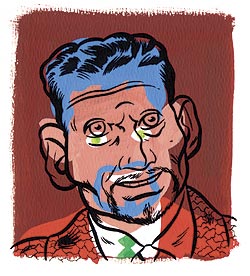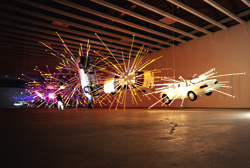Cartoon artists have a long, proud history of pushing people’s buttons. Gary Larson once baffled and infuriated readers with a Far Side panel depicting odd objects in a field captioned “Cow tools.” In “Real Art—A Question of Culture,“ at Sessions Gallery, a cozy basement space in Ballard (through Sunday, Dec. 18; 206-234-5000), a group of illustrators and cartoonists take issue with the established definition of art and make a good case for the legitimacy of their own work. Curated by Don Hudgins of Sedrat Arts and Sessions owner and artist David Lasky, the show was inspired by a Peter Bagge strip called Real Art, which ran in the political magazine Reason in 2004. In it, Bagge says that much that art institutions deem worthy of respect is actually rubbish, and concludes, “So who needs modern art museums?”
In addition to Bagge’s strip, the show’s highlights include intelligent and artfully drawn work by Bob Rini and Jeremy Eaton (less successful is the work by Lasky, Megan Kelso, and Greg Stump). Illustrator Rini draws on his experience as a Henry Art Museum security guard in his deftly drawn film-noir strip, Fear of Art. A detective searches for a Fabergé egg missing from the (purely fictional) Finley Art Museum. His sidekick is a befuddled young guy who explains at every turn that he doesn’t know what’s up because he’s just “Workstudy.” In the strip’s funniest moment, detective Johnny asks him to recite “artspeak” for kicks, and Workstudy dutifully replies: “The driving force of postmodernism is the breakdown of divisions between high and low culture using modernist strategies. . . . ” He carries on for quite a while with this art-critical blather, which Rini is clearly mocking.
“Modern art has always been influenced by the mass media and popular culture,” says Rini. “Warhol obviously used mass media. Lichtenstein ripped those benday-dotted paintings whole from EC Comics and gave it a fine-art sheen. . . . I’m really happy to be a part of this show in which cartoonists get a chance to comment on the art scene. To take revenge, actually, since comics have always been looked down upon by the official art world as a grimy distant cousin, rude and common, at best a poor relative at the high table of ‘fine art.’ Or not considered at all.”
Yet arguably, the cartoonists’ position as art-world outcasts is precisely what frees them to shoot such accurate darts at social hypocrisies and idiocy. This notion is cleverly on display in Eaton’s series of gouache portraits, parodies of 15 fictitious yet familiar “Criminals of the Art World.” The British-born illustrator/cartoonist’s hilarious rogues’ gallery was a favorite at the show’s opening, as much for the witty text as for the agile art—dark quick lines and swashes of color. Eaton drew them all off-register to varying degrees, based on how unhinged they are.
They range from Dinny Tarbuck, the Post-Modern Bead Artist, whose ridiculous masterpiece is The Statue of Beadity, to Mandalet Blanchet, the Surrealist, whose “art crime” is an installation pompously titled The gentry, asleep, masticating, unfed, indigenous fear, a cup of wine, 1993 and which features “the voice of a young girl reading from Kierkegaard’s The Sickness Unto Death.”
“Arty pretense is an overwhelmingly ripe thing to sink my teeth into,” admits Eaton, who diplomatically also satirizes The Artist—himself.
There are other signs that the art establishment’s attitude toward the lowly comic artist may be changing. “Masters of American Comics” just opened concurrently at two Los Angeles venues, UCLA’s Hammer Museum and the Museum of Contemporary Art, recognizing 15 artists who influenced the development of the comic strip in the 20th century—including George Herriman (Krazy Kat), Robert Crumb, and Art Spiegelman, whose graphic novel about the Holocaust, Maus, won the Pulitzer Prize. Now that the local provocateurs of “Real Art” have skewered most of us in the art world, do they ever expect to work as artists in this town again? Let’s hope so.








